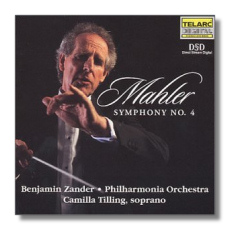
The Internet's Premier Classical Music Source
Related Links
- Mahler Reviews
- Latest Reviews
- More Reviews
-
By Composer
-
Collections
DVD & Blu-ray
Books
Concert Reviews
Articles/Interviews
Software
Audio
Search Amazon
Recommended Links
Site News
 CD Review
CD Review
Gustav Mahler

Symphony #4
Camilla Tilling, soprano
Philharmonia Orchestra/Benjamin Zander
Telarc 2CD-80555 DDD 2CDs 58:25+78:58 bonus disc
Zander's revelatory Mahler Fifth (Telarc 2CD-80569) is followed by a Fourth that, without self-indulgence or exaggeration, similarly helps you to hear a familiar symphony in a new light. This conductor is dedicated to Mahler's text, but (and this is important) he is even more dedicated to the meaning behind the text. To prepare himself to discover and uncover all that Mahler intended (and perhaps also what lay in Mahler's subconscious), Zander has done his homework again. Rather than conducting the symphony in a vacuum, as it were, he conducts it in the light of the musical and other cultural influences that swirled around Mahler in the 1890s. He also relates the symphony's contents to the composer's personal life without resorting to facile or over-obvious "pop psychology."
Zander shows that an objective interpretation need not be a dull one. His attention to detail inspires attentive listening in turn. His conducting is anything but metronomic, and so the score always breathes, and always moves forward with natural, unhurried eloquence. In the second movement, concertmaster Christopher Warren-Green's realization of the scordatura violin writing is chillingly compelling. Zander rightly remarks that this is an embodiment of evil in music, and yet in the same movement, the conductor can make Heaven appear before our very eyes. The Philharmonia plays radiantly throughout – better, I think, than on its recording of the Mahler Fifth. Swedish soprano Camilla Tilling is a find. Young and not well known (she has performed at Covent Garden and at the Metropolitan Opera, however), her innocent, boyish timbre and unforced exuberance are wedded to mature musicianship to produce a realization of the fourth movement that is just about perfect.
As with Zander's Mahler Fifth, a free "bonus disc" has been included. The conductor is an excellent educator, and movement by movement, he helps listeners, even those who are very familiar with this work, to find new reasons to be in awe of Mahler's genius, and to appreciate him as both a composer and as a human being. Zander starts with the last movement, which seems odd, until one remembers that this is the movement that Mahler wrote first; the first three movements then were written to support it like the gold setting around a diamond solitaire. Relevant snippets from almost a dozen recordings supplement Zander's comments. One of the most moving is an excerpt from a live performance of the Fourth that Zander and the New England Conservatory Youth Philharmonic gave in Vienna in 1983. Here, Zander uses a boy soprano named James Westman in the final movement, and the experiment (approved after the concert by Mahler's niece!) is a success. (Leonard Bernstein was less fortunate when he tried the same thing in his last recording of this work.) a complete release of this live recording would find an audience for sure.
Like Zander's interpretation, the engineering (by Telarc veteran Jack Renner) is warm, natural, and unmarred by histrionics. The venue was Walthamstow Assembly Hall in London, and Renner has realistically preserved the music and the "sound" of the space it exists in.
Copyright © 2001, Raymond Tuttle





















